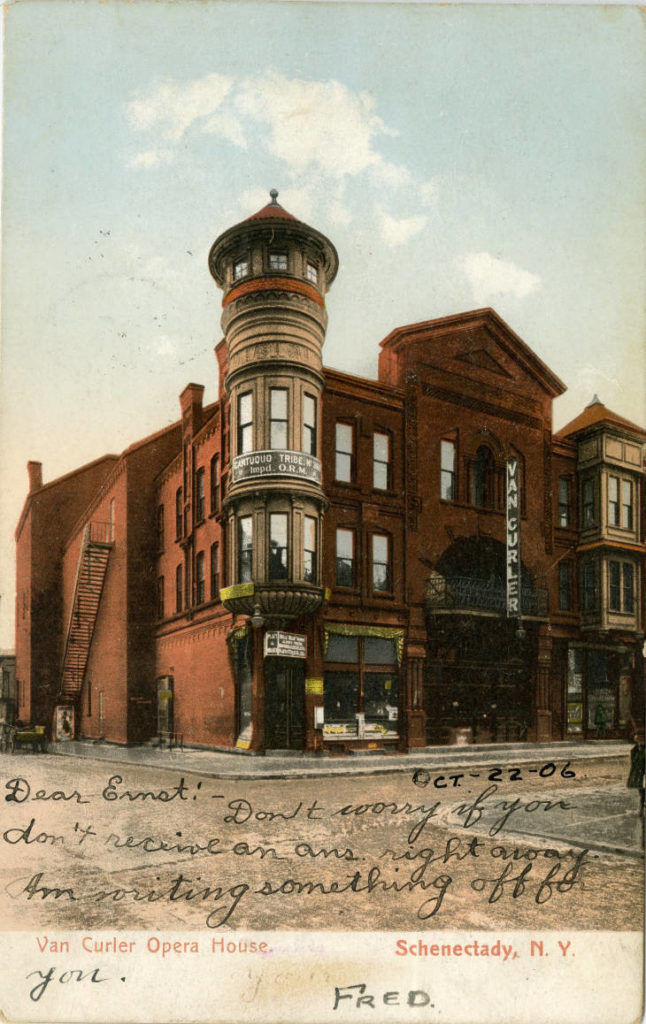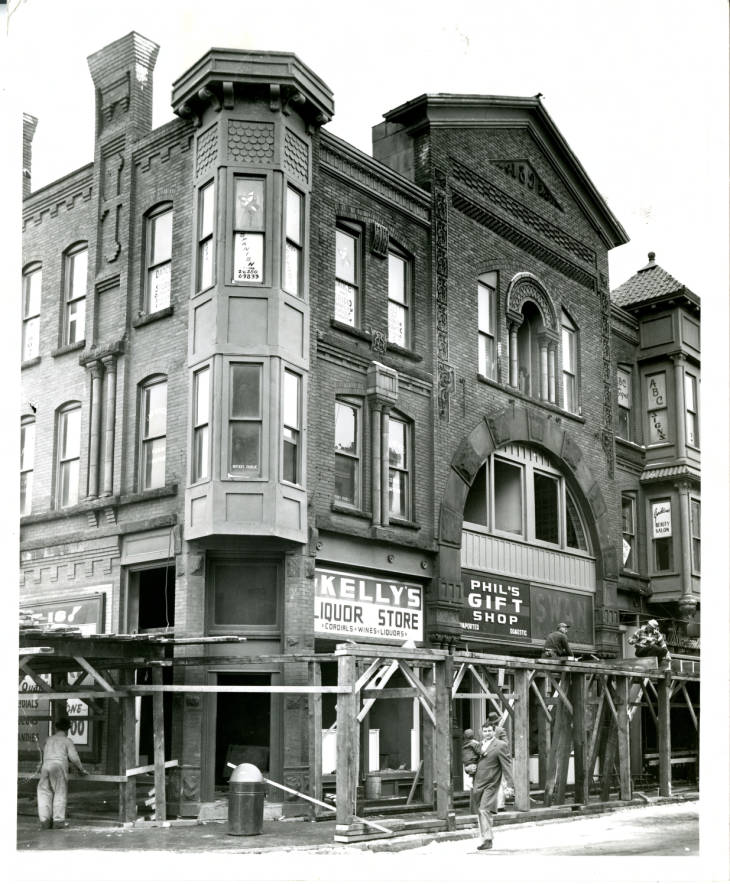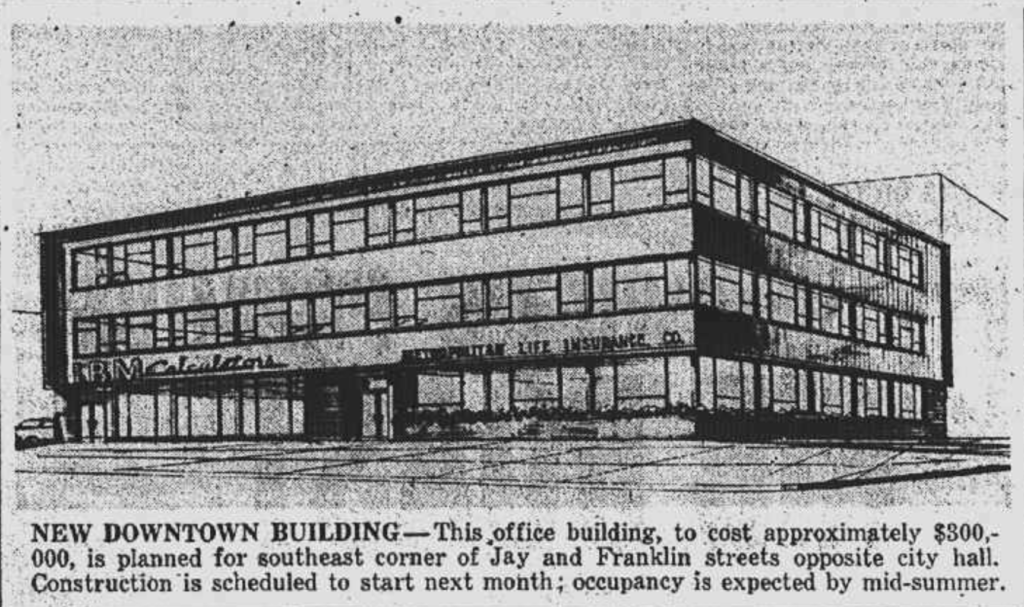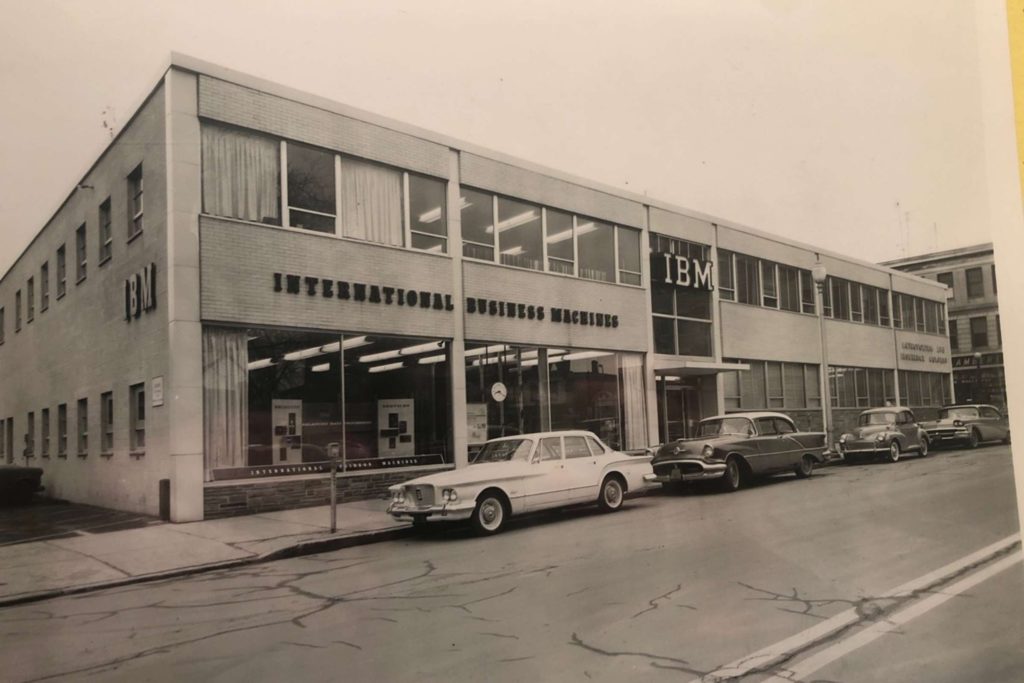Last time, we wrote about The Miles Theatre, a flash in the burlesque/vaudeville pan that existed pretty much within the confines of 1920 in Schenectady. Before that, it was a much grander house known as the Van Curler Opera House. It opened in 1893 at the corner of Jay and Franklin, and lasted in some form into the 1930s. (For those who don’t know, Arent Van Curler — and you can spell his first and last names any number of ways — was considered the founder of Schenectady.)
Soon after it opened, the New York Dramatic Mirror wrote, in 1893, that “The attractions played thus far this season at the Van Curler Opera House have been of the highest order. Manager [Charles H.] Benedict will handle no cheap cos [companies], and the theatregoing public should bear this in mind and give him the patronage he deserves.”
For a description of the Van Curler Opera House, we’re indebted to Larry Hart, who featured it in “Schenectady’s Golden Era, 1880-1930.” Mr. Hart, in turn was indebted to an illustrated edition of the Schenectady Gazette from 1898, which drew an incredibly full description of Schenectady’s newest house of entertainment. There’s so much detail here, we hate to edit it down, and so we won’t.

“The location of the Van Curler, at the southeast corner of Jay and Franklin Streets, is central. It is only one short block from State Street and the electric cars and, while close to the principal hotels and the railway station, is far enough removed from the latter to be beyond the disturbing sound of the steam cars.
“The opera house building is an imposing and substantial structure of brick and stone. The front is of Philadelphia pressed brick and cut brown stone; it is in the Moorish style of architecture, and is elegant and attractive in appearance. The building has a frontage of 98.5 feet on Jay Street and extends back on Franklin Street 144 feet. The main entrance to the theatre is 20 feet in width and equal to two stories in height. The front of the building above the entrance is four stories high. There are three stories south of the entrance on Jay Street and one to the north, at the corner. The entrance, or lobby, is 40 feet in depth.
“To the right, as you enter the lobby, is the box office, about half way down to the doors opening into the foyer. The box office is connected with the manager’s office on the east. To the left of the lobby is a cloak room. The gents’ retiring room is at the left of the foyer, the ladies’ at right. Three sets of folding doors of polished cherry open into the foyer, which is about 40 feet by 12, extending across the rear end of the auditorium from which it is shut off by heavy silk draperies which are substituted for doors. The floor of the foyer is of mosaic stone. At either side, or end, of the foyer are broad stair cases leading up to the balcony.
“Separating the silken draperies, you pass from the foyer into the orchestra circle occupying the ground floor of the auditorium which is about 63 by 63 feet. This floor is saucer shaped and the seats are so arranged on an incline that a clear and uninterrupted view of the stage is obtainable from any and every seat. The orchestra seats are separated from the orchestra circle by a very ornamental partition. Directly in front of the orchestra circle are four loges, partitioned off by polished brass rods. The loges in the central portion of the floor contain five chairs, while the two at either side hold only three. The chairs on the entire ground floor and in the balcony are of the latest improved pattern with the best wire-spring cushions, upholstered in coral crushed plush.
“The cap of the rail dividing the circle and orchestra is upholstered with plush of the same color and surmounted by a brass rail. There are eight boxes, two on each side of the orchestra and two more above on a line with the balcony. The height from the floor to the dome is nearly 68 feet. Gracefully circling above the orchestra circle is the balcony, and towering above this, away up toward the top of the theatre, is the gallery or ‘heaven.’ The balcony contains 350 chairs, precisely the same as those on the ground floor, while the gallery has 450 folding seats. The line of sight is perfect from every seat in the balcony or gallery or on the first floor.
“The ornamentation of the interior of the opera house is magnificent. The general color on the sidewall is terra cotta. The ornamentation on the proscenium arch, the private boxes and on the fronts of the balcony and gallery is sterro-relief and finished in old ivory, light pink and gold. The center of the ceiling forms an immense dome and around this are four figures representing those four of the muses who are supposed to exert an especial influence over a Temple of Thespis, Viz.: Euterpe, goddess of music; Melpomene, goddess of tragedy; Terpsichore, goddess of dancing; and Thalia, goddess of comedy. Each of these figures is a real work of art. The figures are eight feet in height.

“The entrance to the gallery is on Franklin Street. The gallery ticket office is up stairs. There are five exits from the first floor, six from the balcony, six from the gallery and three from the stage. Fire escapes lead from the gallery to the ground, meeting platform exits from the balcony.
“The stage of the Van Curler is one of the largest and best appointed theatre stages in the country. The stage is 72 feet wide and 40 feet deep from curtain line. The height of the stage from the floor to rigging loft is 60 feet; to roof, 80 feet; to fly gallery, 30 feet. The proscenium arch is 36 feet wide and 30 feet high. There are five sets of telescoped grooves, adjustable to scenery from 16 to 28 feet high. There are two lines of workbridges . . . and 350 lights on stage with 99 foot lights (electric) with red, white and blue globes, to use instead of calcium effects.
“There are two curtains, one fireproof asbestos, and one scene curtain representing the Towers of the Alhambra after a Moorish sketch by Sir David Roberts. There are 63 separate scenes in all, including mountain, garden, horizon, wooded landscape, old street and new street scenes, palace, light and sides rocks, vases, statuary, prison and kitchen scenes, dark chamber scenes, gothic, bridges, set houses, set cottages and in fact everything necessary for a well regulated stage.
“There are 17 dressing rooms, about 9 by 12 feet. They are in an annex on the south of the stage, which is cut off by fire proof doors. In the cellar beneath the annex is the heating plant, the steam for the stage and theatre being furnished by a 40 horsepower boiler. There are six fire plugs on the stage and each furnished with 100 feet of hose. The stage is entirely shut off from the auditorium by a fire wall, added to the original plans at an extra cost of $1,480, and the fire proof asbestos curtains. All the wiring in the theatre is covered by fire proof pipe, and in fact every possible precaution has been adopted to render the theatre as near fire proof as stone, brick and mortar can be made.
“The plans for the Van Curler Opera House were furnished by Leon H. Lempert & Son, architects, of Rochester. The following are the contractors who built it: John McDermott, mason work; William G. Caw, carpenter work; John Allen, steam fitting; Stevenson Bros., plumbing.”
Hart wrote that the opera house cost $100,000. It opened opened March 1, 1893, with a showing of a play titled “Friend Fritz,” and was quickly established as one of the top theaters of its day, featuring acts like Al Jolson, Eddie Cantor, George Jessel, Ziegfeld Follies, and shows like “Show Boat,” “Ben Hur,” and “Song of the Desert.” It premiered Broadway shows of the Schubert and Comstock and Gest organizations. A later Gazette article said that ““Dances were staged in the theater auditorium through use of special jacking devices which raised and lowered the floor. John Philip Sousa’s band also appeared there. The theater also brought in more serious entertainment. Jascha Heifetz appeared in the opera house during one of his first tours in this country as solo violinist. Southern and Marlowe put on Shakespearean plays and the old Russian symphony orchestra gave concerts.”
Hart wrote that the Van Curler began showing movie travelogues by Lyman K. Howe around 1910, and that he made annual appearances that drew large crowds.

As we noted, in 1920 the theater became part of a little-known vaudeville circuit known as Miles, and changed its name accordingly; however, that name change didn’t go over particularly well, and it was soon modified to Van Curler Theater. Hart reported that in 1925, the house was sold to the Farash Corporation, which introduced burlesque.


At some point the theater business went under, and the building was just used as offices. Hart wrote that in August 1943, wreckers took down the hall east of the offices, and it became a parking lot. The front part survived until 1956, when a $300,000 modern brick and glass low-rise, designed by Harris A. Sanders of Albany, was built in its place; it still stands today. That building initially housed IBM and Metropolitan Life Insurance. It was proposed as a three-story building, though it’s pretty clear there are only two stories. The builders were the Backer Brothers, who owned Country Squire Motel, Swan Cleaners and other properties .

Leave a Reply